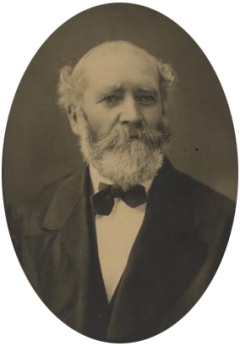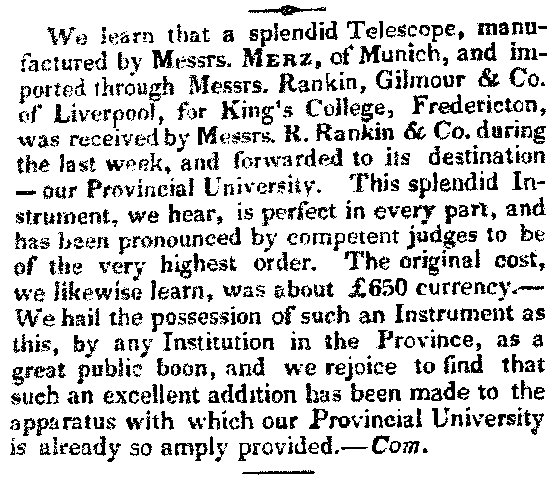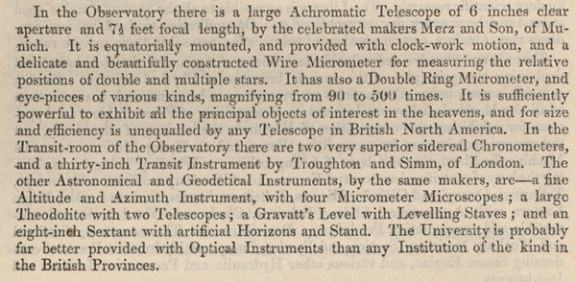By J.E. Kennedy
In the minute book of King’s College, Fredericton, the following entry appears, dated March 19th, 1851 — “a report was read from the committee appointed to superintend the erection of the Observatory, stating that the building had been completed at a cost of ₤170-9-7. Ordered that the report be accepted.”
The existence of this Observatory is due to the efforts of the pioneer Canadian astronomer, William Brydone Jack. From the Genesis of the University of New Brunswick (Raymond, 1919), the following has been extracted: “William Brydone-Jack was in many respects an admirable representative of the Scottish race. He possessed the strong moral fibre characteristic of his ancestry, the rugged tenacity of purpose and strong common sense, the courage and perseverance, the cheerful optimism and energy essential to successful leadership. As a young man he was endowed with an unusually fine physique. He was tall—rather more than six feet in height—strong and vigorous. He liked life in the open air, was an excellent walker, and almost as much at home in practical surveying as he was in the lecture room, or in the College observatory. He was fond of working in his garden, liked and drove spirited horses and enjoyed the game of curling. He was an entertaining companion, interested in the affairs of the day, and in the well-being of the community, patriotic in his sentiments and social in his instincts. For many years he was an active member and office bearer in the Saint Andrews Society. He was at his best on the occasion of any public function and even those students who had little love for mathematics and stood in awe of the Doctor in the class-room, were proud of him when he presided at the Annual Encaenial festival. He was a brilliant mathematician, quick and accurate in his work and exceedingly neat in his diagrams both on paper and at the black-board. It was always a surprise to the assembled class to see the ease and accuracy with which the Doctor with graceful free arm movement would draw upon the black-board a perfect ellipse.
“He had the gift of sarcasm and was not always patient with the duller intellects in his classes. Unfortunately in the curriculum of those days there were no optional subjects and there were always certain students to whom the pass-mark of twenty-five per cent in Analytics and Calculus was a veritable night-mare. But to the “mathematicians” of the various classes there was a never to be forgotten charm in the Doctor’s manner in the lecture-room. While pre-eminent in mathematics, he was an all-round scholar. Of this we have ample proof in the Encaenial addresses that have come down to us. It may also be noted that upon the death of the Classical Professor, George Montgomery-Campbell, in April, 1871, Dr. Jack solved a problem that had arisen respecting the work with the senior class by himself taking the subject of Classics with the seniors for the balance of the year.
“Previous to a serious attack of congestion of the lungs in the winter of 1866-67, from the effects of which he never entirely recovered, the Doctor did a good deal of field work in connection with the course in surveying. He also made much use of the observatory. This modest little building was built in 1851. Its fine equatorial telescope, made by the famous Merz & Sons, was for some time the best in British North America, and the other astronomical accessories were regarded then as quite up to date. The many hundreds of careful observations which Dr. Jack took show that astronomical work was to him a labour of love. He was always particularly interested in any discovery or invention pertaining to science. After the establishment of lines of telegraph communication he was among the first to make use of them in determining with accuracy differences of longitude. By exchange of signals with Professor Bond of Harvard University, the true longitude of Fredericton was ascertained. He afterwards, at the request of the New Brunswick government, obtained the exact longitude of Saint John. In 1856, as discrepancies were found to exist in the longitude of places in the Northeastern boundary between Maine and New Brunswick, as taken by the British and the United States surveyors, it was deemed important to settle the points at issue by the electric telegraph. Accordingly the longitudes of Grand Falls and Little Falls (or Edmundston) were determined by this method. The longitude of Quebec was determined in a similar way in November, 1855.
“After the establishment of a meteorological observatory at the University, soon after the Confederation of the provinces, daily observations were made by Dr. Jack until he retired from the Presidency of the College in 1885.”
What inspired Brydone Jack to undertake the construction of this modest little Observatory? It may have been the influence of Sir David Brewster, under whom he studied at St. Andrew’s University in Glasgow. It may have been the encouragement he received from the Lieutenant Governor of New Brunswick, Sir Edmund Walker Head. Wherever the inspiration came from, one doubts if Dr. Jack realized initially the magnitude of his undertaking nor the results that would materialize from being “first” in this scientific field. Let us examine the order in which the early observatories in Canada came into existence.
Records show that as late as the year 1835, there were no observatories in the Western Hemisphere (Tory, 1939). This was a matter of concern to Admiralty officials in London who depended on such stations for the accurate determination of time and for fixing of positions. It was decided that the instruments from the dismantled Observatory at St. Helena should be overhauled and sent to Upper Canada. The Imperial authorities build the first Observatory in Canada at Toronto in 1839, but it was primarily a magnetic Observatory and did not acquire a telescope for astronomical work before 1881.
The present Dominion Astronomer, Dr. C.S. Beals, very carefully searched the accounts of the founding of the Observatory at Toronto to determine whether any astronomical instruments had been incorporated in the original building. From an early picture of the Observatory, he found that there was no indication of a dome where proper astronomical instruments could have been mounted. There was a small extension to the building where a surveyor’s theodolite was placed, presumably to get azimuths in connection with the magnetic measurements of declination. He stated that “in my opinion, there is no reasonable doubt that the Fredericton Observatory is the oldest astronomical Observatory in Canada.”
The construction of other observatories in Canada followed; in 1850, Lt. Ashe was appointed astronomer at Quebec and a small Observatory was completed there in 1854 (Tory, 1939). The citizens of Kingston were stimulated by a solar eclipse of the same year to secure a telescope and start astronomical observations there by 1857.
What type of building is the First Astronomical Observatory in Canada? Two pictures, taken of the Observatory in the early days of its existence, have been presented to the Archives section of the U.N.B library quite recently. While no attempt has been made to assign an accurate date to this reproduction, one can safely assume that it is mid-nineteenth century and not later than 1870.
Last year, the Astronomer Royal, Sir Harold Spencer Jones, uncovered a sketch plan of the original building while the Archives of the Royal Greenwich Observatory were being searched for correspondence from Dr. Jack. In June 1854, Brydone Jack had submitted this plan, attached to a letter to the Astronomer Royal [George Biddell Airy]. And extract from this letter states: “I also avail myself of the present opportunity to give you an account of a small Observatory which I have had constructed on a very economical plan for King’s College, thinking it might be useful to some amateur astronomers who might wish to erect similar buildings. It is built of wood and consists of an octagonal tower for the equatorial, 14 feet across, and two wings, each 12 feet square.”
Whether any observatories were built in other countries from this sketch plan and are still in existence is unknown. The author is not aware of a building of similar construction in either the United States or Canada. The eight-sided dome and pyramidal roof tend to make its construction unique.
It is interesting to read the data recorded over a century ago as Brydone Jack persuaded the governing body of King’s College to devote the funds required for building and equipping this modest Observatory. In March 1847, a Council report showed that “the sum of ₤550 sterling may be devoted to the object in view which they recommend should be appropriated as follows—namely ₤300 for the Mathematical Department to be applied in the purchase of a good 7 feet achromatic Telescope”…In June 1847, the Council of King’s College ordered the “the further sum of ₤50 sterling be appropriated for that object (telescope) if required.”
Within a year, this same Council decided “that the Telescope now proposed by Professor Jack at an original cost of ₤336 sterling, with the building and apparatus necessary for its proper use, are more than the wants of the College require or the funds will warrant.” A Committee was authorized to make arrangements for annulling the order and to get the best instrument at a cost not exceeding ₤100 sterling over and above that sum of ₤110 sterling already advanced to the manufacturer.
One can visualize that the committee experienced considerable difficulty with the manufacturer over the annulment of this order. In October 1848, a letter was read to the Council from Messrs. Merz of Munich and the Registrar was immediately ordered to “adopt measures for getting the telescope.” The instrument arrived in New Brunswick in May 1849, and was given the following acclaim in the New Brunswick Courier newspaper:
The Journal of the House of Assembly for New Brunswick, in the year 1854, gives a consolidated listing of all apparatus in the College and amounts spent on Philosophical Apparatus in the seven years 1846-1853. It clearly states that “the last sum includes ₤504-11-9 paid for the Telescope.” This amount should be regarded as more reliable than the one quoted by the newspaper.
The decade, 1851-61, following the completion of the building, may long be regarded as the most glorious years of the U.N.B. Observatory. Brydone Jack must have displayed a tremendous energy, drive and enthusiasm in that period. There is no question that the founding of the Observatory quickened the interest in practical surveying, which prompted the University to start courses in Engineering Instruction in 1854. During the years, 1854-56, Dr. Jack was busily engaged in using the “electric telegraph” for the determination of longitude of various centres in the Province. Signals were exchanged with Professor Bond at Harvard Observatory. Then, because of a slight discrepancy in the values taken by the British and American surveyors, numerous exchanges of correspondence followed between Dr. Jack, the Astronomer Royal, Professor Bond, and Lt. Ashe at Quebec. An effort is being made to collect the relevant material to determine how this problem was settled.
In 1876, through the efforts of Dr. Jack an additional storey was added to the University Building and the chimneys were raised to a new elevation, but not changed in bearing with reference to the true meridian line. Over a period of years, trees gradually began to obscure the conspicuous objects from view, and in 1892, another point G was added, the top of the lightning conductor of the Parliament Building. The “new” Buff and Berger Theodolite, with which the bearing of this object was taken is still used by students in surveying at the University today.
Perhaps even better than many who have followed him, Brydone Jack realized that a University, without adequate library facilities and essential Philosophical apparatus, could never inspire nor arouse a thirst for knowledge in its students. Hence, it is not surprising to read the following extract in the University Calendar for the year 1864-5:
All of these instruments have not yet been located, but the large equatorially mounted telescope and micrometer eyepiece are nearly restored to operating conditions. The historic transit instrument has been preserved and its stone pillar, together with base casting, may at some future date be replaced in its original position in the Observatory. There is still hope that other items among this equipment may be found.
A small volume in the Archives of the University Library contains the following (Bailey): “A modest monument in the Old Burying Ground marks the last resting of Dr. Jack, of Manus the Mathematician. Requiescat in pace.”
With the recent unveiling of the plaque on the First Astronomical Observatory in Canada (Kennedy, 1955), a fitting memorial has at last been dedicated to the many achievements in astronomy of William Brydone Jack.
References
- Bailey, Joseph Whitman. "Anecdotes and Reminiscences."
- Kennedy, J.E. 1955, R.A.S.C. Jour., vol. 49, p. 151.
- Raymond, Archdeacon W.O. 1919, "Genesis of the University of New Brunswick."
- Tory, H.M. 1939, A History of Science in Canada, Ryerson Press. Chapter VII, The History of Astronomy in Canada (Harper).
- Main Page
- Anniversaries
- Brief History of UNB
- Buildings
- Faculties and Departments
- Governance and Administrative Positions
- Lecture Series
- Official University Events and Symbols
- People of UNB
- Plaques, Monuments and Structures
- Prizes and Awards
- Sports and Athletics
- Student Clubs and Societies
- Student Events and Escapades
- University Publications
- Women's Sports at UNB
- About UNB Archives and Special Collections
Request an Appointment
Prior arrangements must be made for the retrieval of this material. Please email archives@unb.ca to make an appointment.
Procedures
Help Desk Hours
- Monday - Friday
- 10:00 am - 12:00 pm
- 1:00 pm - 4:00 pm
Contact Us
- 5th Floor, Harriet Irving Library
- University of New Brunswick
- 5 Macaulay Lane, Box 7500
- Fredericton, NB E3B 5H5 Canada
- archives@unb.ca
- Staff Directory




